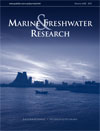Marine and Freshwater Research
Volume 64
Number 8 2013
Aquatic organisms rely on infochemicals to assess predation risk. In this study, we show how kairomones from trout, conspecific alarm cues or a combination of both induce specific behavioural and life-history responses in Daphnia magna. Prey organisms are capable of interpreting complex chemical environments and adjusting the magnitude of their different plastic and inducible antipredator responses.
Studies examining the emergent fauna arising from coral reef substrata are rare. This investigation is the first to compare the fauna migrating from the epilithic algal matrix of a coral reef with the resident diurnal invertebrates from the same habitat, revealing two unique assemblages with an order of magnitude difference in abundance. These observations indicate that the two communities differ markedly in composition, abundance and possible trophic importance to diurnal and nocturnal predators.
We investigated abundance and distribution characteristics of five little understood groups of picophytoplankton in the Pearl River Estuary. It was suggested that Prochlorococcus density and distribution range were balanced by river discharge and saline–water intrusion. The present study showed that low river input resulting from extreme drought events exerted less negative pressure on picophytoplankton abundance.
Sardinian management measures can be considered adequate to guarantee local sustainability of red coral resource. The Beverton and Holt model shows that the red coral fishery in Sardinia reaches its maximum yield at an age at first capture of 20 years, an age significantly lower than the average age of 30 years calculated for the colonies actually harvested. Sardinian regulations can represent a guideline for countries that still lack a valid management plan.
Two morphs of a moon sponge Paratetilla sp. with nearly identical skeletal structures had distinctly different bacterial communities, alerting us to the possibility that the two morphs may not be the same species. Sequence analysis of the cytochrome oxidase I gene and taxonomic evaluation of spicules enabled the two morphs to be distinguished as Cinachyrella (Morph 1) and Paratetilla (Morph 2). This highlights the need for detailed taxonomic examination of sponges, which can have highly variable morphology, often not seen as a priority by ecologists.
Recruitment success in fishes is dependent on factors that affect the survival and transport of larvae to settlement habitats. We aimed to describe the larval recruitment dynamics of snapper, and to investigate whether these dynamics are affected by various environmental variables. Results suggested that, in some locations, high water temperatures, large tides and on-shore winds may increase recruitment success.
Despite its effects, sample acidification has been broadly used in food web studies to reduce inorganic carbon from the samples tested. This work provides insight on how acidification affects the isotope signatures of macrobenthos and helps to standardise the methodology. We conclude that acidification is not always necessary for stable carbon but should be avoided for stable nitrogen determination of macrobenthos.
Otolith Sr : Ca ratio was used as an indicator for describing seasonal movements of the freshwater fish (Odonthestes bonariensis). By employing this tool we found that during summer (December–March) fish move to the Rio de la Plata estuary, while in winter (April–September) their displacements are in the freshwater rivers of Argentina. Otolith microchemistry was an appropriate methodology for describing movements of this commercially important freshwater species.
Invasive species are a major threat to biodiversity and many non-native freshwater fish are invading South America. After testing the predator–prey relationships between the native Salminus brasiliensis and introduced and native fishes in Brazil, we found higher predator success in complex habitats and on smaller and less active preys. Salminus brasiliensis can exert biotic resistance on some invasive fishes in the neotropics, but not to the same degree for all species.
Extraction of water from rivers and estuaries must be limited to protect ecological assets. A standard risk- assessment approach was tested in the Coal Pittwater Catchment and Ramsar-listed Orielton Lagoon, Tasmania, and indicated over-allocation and overuse of water. Future freshwater flows are often uncertain, so, for general application, this ecological-risk approach needs to be supplemented by the use of hydrological indicators that are linked to biological responses.




